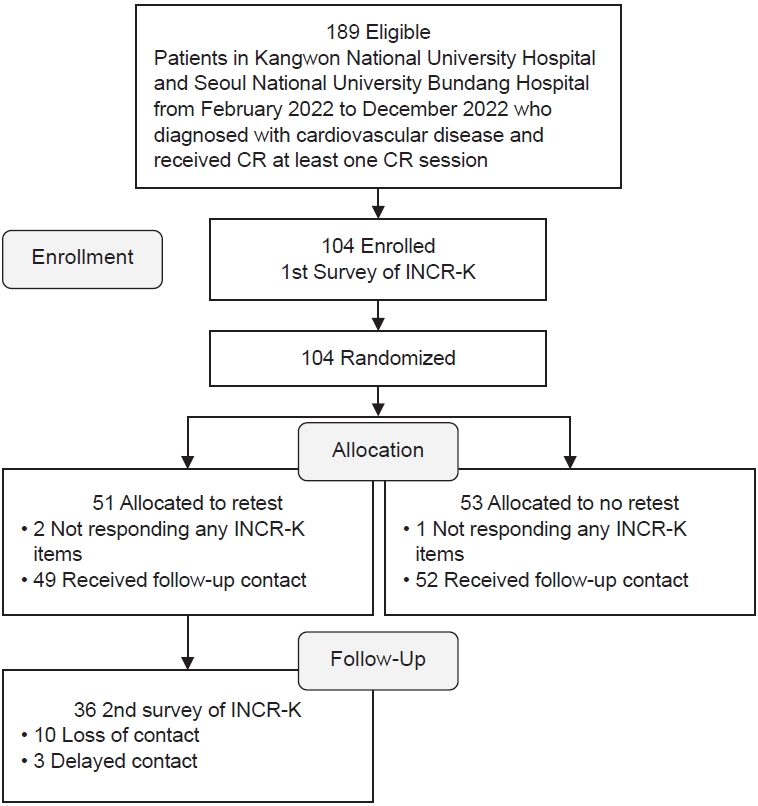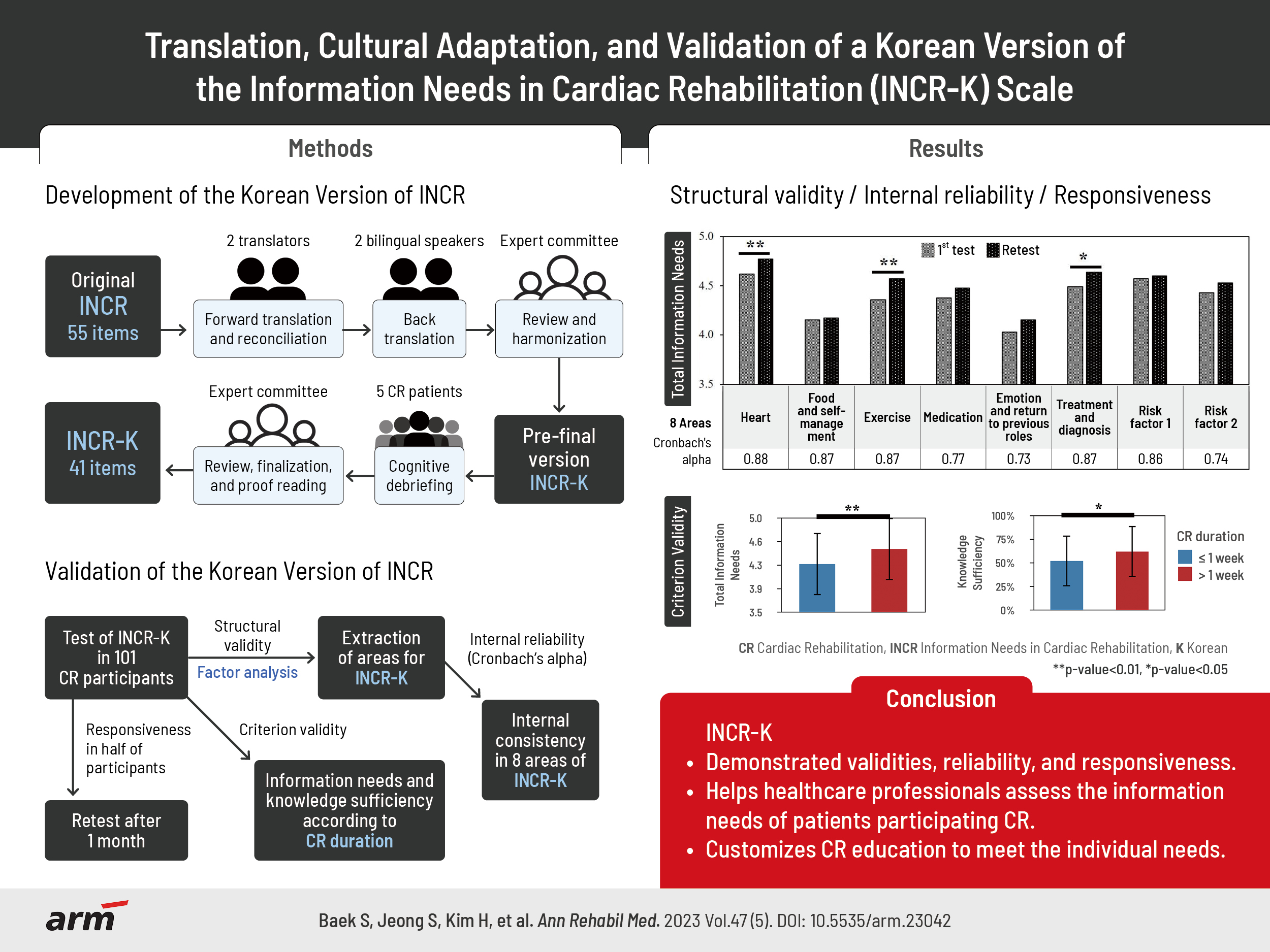1. GBD 2019 Diseases and Injuries Collaborators. Global burden of 369 diseases and injuries in 204 countries and territories, 1990-2019: a systematic analysis for the Global Burden of Disease Study 2019. Lancet 2020;396:1204-22. Erratum in: Lancet 2020;396:1562.


3. Visseren FLJ, Mach F, Smulders YM, Carballo D, Koskinas KC, Bäck M, et al. 2021 ESC Guidelines on cardiovascular disease prevention in clinical practice. Eur Heart J 2021;42:3227-337. Erratum in: Eur Heart J 2022;43:4468.

4. Teo K, Lear S, Islam S, Mony P, Dehghan M, Li W, et al. Prevalence of a healthy lifestyle among individuals with cardiovascular disease in high-, middle- and low-income countries: The Prospective Urban Rural Epidemiology (PURE) study. JAMA 2013;309:1613-21.


5. Moser DK, Dracup KA, Marsden C. Needs of recovering cardiac patients and their spouses: compared views. Int J Nurs Stud 1993;30:105-14.


6. Larson CO, Nelson EC, Gustafson D, Batalden PB. The relationship between meeting patients’ information needs and their satisfaction with hospital care and general health status outcomes. Int J Qual Health Care 1996;8:447-56.


7. Scott JT, Thompson DR. Assessing the information needs of post-myocardial infarction patients: a systematic review. Patient Educ Couns 2003;50:167-77.


8. Decker C, Garavalia L, Chen C, Buchanan DM, Nugent K, Shipman A, et al. Acute myocardial infarction patients’ information needs over the course of treatment and recovery. J Cardiovasc Nurs 2007;22:459-65.


9. Astin F, Closs SJ, McLenachan J, Hunter S, Priestley C. The information needs of patients treated with primary angioplasty for heart attack: an exploratory study. Patient Educ Couns 2008;73:325-32.


10. Czar ML, Engler MM. Perceived learning needs of patients with coronary artery disease using a questionnaire assessment tool. Heart Lung 1997;26:109-17.


11. Lile JB, Buhmann J, Roders S. Development of a learning needs assessment tool for patients with congestive heart failure. Home Health Care Manag Pract 1999;11:11-25.


12. Grace SL, Turk-Adawi KI, Contractor A, Atrey A, Campbell NR, Derman W, et al. Cardiac rehabilitation delivery model for low-resource settings: an international council of cardiovascular prevention and rehabilitation consensus statement. Prog Cardiovasc Dis 2016;59:303-22.


13. Pavy B, Barbet R, Carré F, Champion C, Iliou MC, Jourdain P, et al. Therapeutic education in coronary heart disease: position paper from the Working Group of Exercise Rehabilitation and Sport (GERS) and the Therapeutic Education Commission of the French Society of Cardiology. Arch Cardiovasc Dis 2013;106:680-9.


14. Ghisi GL, Grace SL, Thomas S, Evans MF, Oh P. Development and psychometric validation of a scale to assess information needs in cardiac rehabilitation: the INCR Tool. Patient Educ Couns 2013;91:337-43.


15. Ghisi GL, Dos Santos RZ, Bonin CB, Roussenq S, Grace SL, Oh P, et al. Validation of a Portuguese version of the Information Needs in Cardiac Rehabilitation (INCR) scale in Brazil. Heart Lung 2014;43:192-7.


16. Ghisi GLM, Anchique CV, Fernandez R, Quesada-Chaves D, Gordillo MX, Acosta S, et al. Validation of a Spanish version of the information needs in cardiac rehabilitation scale to assess information needs and preferences in cardiac rehabilitation. J Cardiovasc Nurs 2018;33:E29-34.


17. Ma C, Yang Q, Huang S. Translation and psychometric evaluation of the Chinese version of the information needs in cardiac rehabilitation tool. J Cardiopulm Rehabil Prev 2019;39:331-7.


18. Choi SYH, Kim JH. Reliability and validity of Korean-version of information needs in cardiac rehabilitation scale. J Korean Phys Ther 2022;34:234-41.

19. Mokkink LB, Terwee CB, Patrick DL, Alonso J, Stratford PW, Knol DL, Bouter LM, de Vet HC. The COSMIN study reached international consensus on taxonomy, terminology, and definitions of measurement properties for health-related patient-reported outcomes. J Clin Epidemiol 2010;63:737-45.


20. Wild D, Grove A, Martin M, Eremenco S, McElroy S, Verjee-Lorenz A, et al. Principles of good practice for the translation and cultural adaptation process for patient-reported outcomes (PRO) measures: report of the ISPOR task force for translation and cultural adaptation. Value Health 2005;8:94-104.


21. Hair JF, Anderson RE, Tatham RL, Black WC. Multivariate data analysis. 5th ed. Prentice Hall; 1998. p.1-730.
22. Pescatello LS; American College of Sports Medicine. ACSM’s guidelines for exercise testing and prescription. 9th ed. Wolters Kluwer/Lippincott Williams & Wilkins Health; 2014.
23. Shrestha N. Factor analysis as a tool for survey analysis. Am J Appl Math Stat 2021;9:4-11.

24. Kaiser HF. The application of electronic computers to factor analysis. Educ Psychol Meas 1960;20:141-51.


25. Taherdoost HA, Sahibuddin S, Jalaliyoon NE. Exploratory factor analysis; concepts and theory. Adv Appl Pure Math 2022;27:375-82.
26. Terwee CB, Bot SD, de Boer MR, van der Windt DA, Knol DL, Dekker J, et al. Quality criteria were proposed for measurement properties of health status questionnaires. J Clin Epidemiol 2007;60:34-42.


28. Stockler MR, Osoba D, Goodwin P, Corey P, Tannock IF. Responsiveness to change in health-related quality of life in a randomized clinical trial: a comparison of the Prostate Cancer Specific Quality of Life Instrument (PROSQOLI) with analogous scales from the EORTC QLQ-C30 and a trial specific module. European Organization for Research and Treatment of Cancer. J Clin Epidemiol 1998;51:137-45.


30. Arthur HM, Patterson C, Stone JA. The role of complementary and alternative therapies in cardiac rehabilitation: a systematic evaluation. Eur J Cardiovasc Prev Rehabil 2006;13:3-9.


31. Wood MJ, Stewart RL, Merry H, Johnstone DE, Cox JL. Use of complementary and alternative medical therapies in patients with cardiovascular disease. Am Heart J 2003;145:806-12.


32. de Melo Ghisi GL, Grace SL, Thomas S, Evans MF, Sawula H, Oh P. Healthcare providers’ awareness of the information needs of their cardiac rehabilitation patients throughout the program continuum. Patient Educ Couns 2014;95:143-50.


33. Ghisi GL, Britto R, Motamedi N, Grace SL. Disease-related knowledge in cardiac rehabilitation enrollees: correlates and changes. Patient Educ Couns 2015;98:533-9.


34. Chan V. Content areas for cardiac teaching: patients’ perceptions of the importance of teaching content after myocardial infarction. J Adv Nurs 1990;15:1139-45.


36. Wingate S. Post-MI patients’ perceptions of their learning needs. Dimens Crit Care Nurs 1990;9:112-8.














